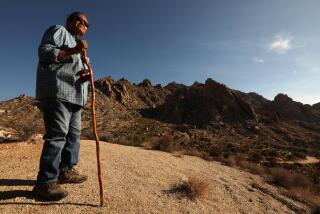War in Nevada Skies : Simulated Combat With ‘Soviet Aggressors’ Has Taken 41 Lives
- Share via
LAS VEGAS — In what is considered the ultimate computerized war game, combat pilots from around the world attack airfields that resemble Soviet Bloc targets and engage supersonic jets that replicate Soviet MIGs.
Operation Red Flag, a six-week-long operation held four times a year, teaches pilots in its classroom--the airspace over the Nevada desert--how to survive and prevail in modern warfare.
The current exercise, which runs through Feb. 15, features 27 types of aircraft from all four U.S. military branches, in addition to the Canadian air force. More than 300 aircraft are expected to fly about 5,000 missions.
For 10 years, thousands of American pilots and hundreds of their counterparts from 16 friendly foreign countries have dodged simulated Soviet defense systems and engaged in dogfights with “red aggressors” in the war over 3,800 square miles.
41 Pilots Killed
Forty-one pilots have died in Red Flag operations, testimony to the intensity of the simulated combat operations.
“Red Flag is the highest rung, next to combat,” said Col. John Madden, a former combat pilot who directs the $19-million annual program. “It’s the closest thing to combat I’ve ever seen.”
In three tours of duty in Southeast Asia, Madden registered three MIG kills and one enemy plane damaged, ranking him No. 3 among Americans in MIG kills.
The simulated-combat games began after heavy losses of U.S. pilots in Vietnam. In the first Red Flag exercises a decade ago, nine types of aircraft participated, with 55 planes flying 1,300 sorties.
A typical Red Flag operation features strike aircraft sweeping between mountain peaks to knock out enemy defenses such as surface-to-air missiles. The defenses have video cameras to film the pilot’s attack and determine whether he was able to reach the target, knock it out, and escape alive.
“This allows us to see ourselves in the eyes of the enemy gunner,” Madden explained. “It’s all there to see on the videotape. This is the only range in the world where pilots can go and see the vast variety of Soviet threats. We present a direct replica of what a pilot would face in combat. Intelligence tells us what they know (about Soviet defenses) and we try to replicate it.”
Ford Aerospace has a $16-million contract to set up the toughest defenses possible on the Nellis range. The intensity of the defenses increases with each day of a Red Flag operation; knocking out the missile sites and bunkered positions is a major goal.
Reconnaissance aircraft such as AWACS (airborne warning and command systems) are used to help choreograph the attack and set defensive systems. Other aircraft provide electronic jamming and countermeasures. Giant transports provide airlift support, including parachute drops to friendly forces. Helicopters sweep across the desert on search-and-rescue missions.
Giant B-52s whip across the range, hugging the desert at 200-foot altitudes looking for targets such as airfields and vehicle convoys. KC-135 tankers circle the east and west sides of the vast range, refueling planes as they would under combat conditions.
The threats don’t originate from the desert floor alone. In each exercise, 40 F-5E jets, with configurations similar to MIG-21s and 23s, engage in dogfights with F-16s and other friendly forces.
The “red aggressors,” specially trained American pilots who fly and fight like their Soviet counterparts, attack “blue friendly” forces and try to prevent their penetration into the target area. According to the game’s scenario, 40,000 Soviet troops have attacked a friendly nation.
“We want our pilots fighting someone as similar to a Soviet pilot as you could get,” Madden said. “We have 40 aggressor aircraft and pilots and they’ll outnumber the blue air (forces) 2 to 1 or 3 to 1. That’s because the Soviets have more fighters than we do.”
All Aircraft Monitored
Huge screens monitor the flight of every plane on the sprawling Nellis range, as well as other military and commercial craft in a 542-mile radius.
The range runs north from Las Vegas for 150 miles and is 120 miles wide at the northern edge. From 80 to 100 aircraft fly through the target area within a five-minute period.
The ability to replay the battles will leap forward in September with completion of a system that will track 136 aircraft over the entire range, being fed data from pods carried on each plane’s wing tip.
“It will give us the big picture of what went on out there,” Capt. Hal Westbrook explained. The full battle scenario is available on three-dimensional screens, giving a horizontal look, a vertical view and “an overhead God’s-eye view,” Westbrook said. The screens show the airspeed of each plane, its position, altitude and threats launched against it.
Westbrook pointed to a blue F-16 and a red F-5 approaching each other at a closing speed of nearly 900 m.p.h.
A second screen showed the view from the blue plane’s cockpit. With the aggressor in his sights, the blue plane fired. An outline of a coffin flashed across the target, indicating a kill.
More to Read
Sign up for Essential California
The most important California stories and recommendations in your inbox every morning.
You may occasionally receive promotional content from the Los Angeles Times.










